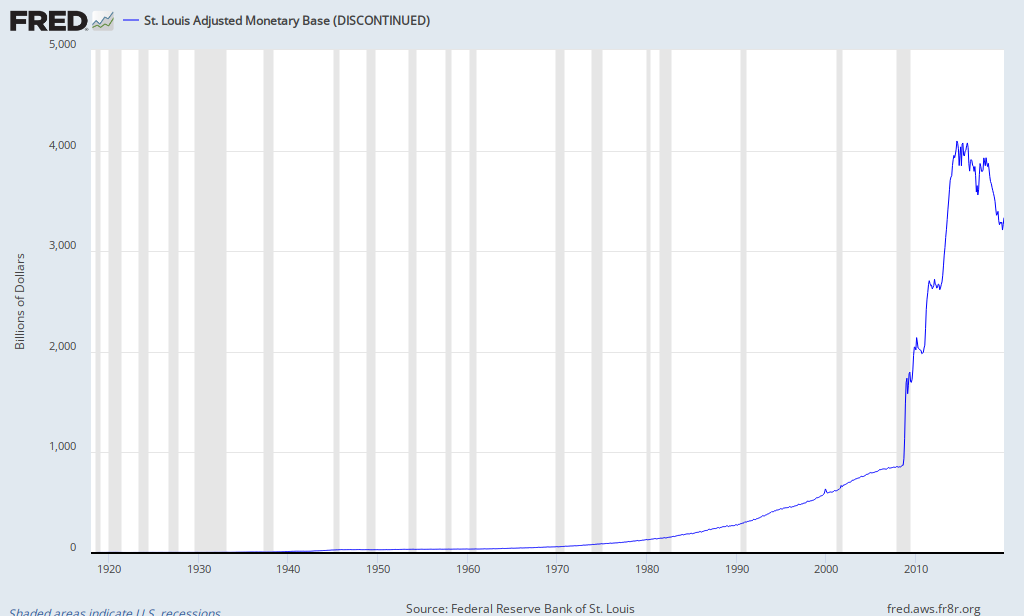The credit contraction we've seen and will see is massive. The credit card companies are already cutting limits, prime brokers are pulling in unused lines from hedge funds, upside down mortgages that have to be written off, it's in the Trillions, maybe tens of trillions. The Fed, the Treasury, the Bureau of Engraving can't reliquify as fast as we're contracting.The only thing that's changed in the intervening 4 1/2 years is the immediacy of the problem not its underlying nature.
-Fed Adds Most Reserves Since 9/11 Attacks as Banks Hoard Cash
From Bloomberg:
Why Global Economies Face an Age of Deflation
In recent years, monetary and fiscal stimulus across the world have led to the assumption that serious inflation, if not hyperinflation, is on its way. I believe chronic deflation is more likely.The last time we visited the writer of the above piece, in February's "A. Gary Shilling and the Prospect of a 1% Ten Year", I felt compelled to point out two of his recent incorrect calls, and probably should do so again:
The expectation of rising prices is reasonable. Most people have only experienced inflation. The last meaningful episode of deflation was in the 1930s. That’s also the last time the U.S. was truly at peace. Deflation is a peacetime phenomenon.
The U.S.’s bouts of inflation, however, have historically occurred during wartime. That applies not only to shooting wars, but to the Cold War and the War on Poverty. These are periods when vast overspending by the federal government is combined with a robust private economy. These aren’t the conditions we have today, when government stimulus can’t offset private-sector weakness.
In the 95 wartime years since 1749, wholesale price increases averaged 5.7 percent. In the 168 peacetime years, they fell 1.2 percent annually on average. As the U.S. withdraws from Iraq and Afghanistan and as defense spending declines, peacetime conditions are likely to prevail.
Furthermore, we tend to have biases that cloud our perception of inflation. When we pay higher prices, we think inflation is at work, but we believe lower prices are a result of our smart shopping and bargaining skills.
Consumer Prices
Even though deflation has been forestalled in the past decade, disinflation -- declining rates of inflation -- has prevailed since the early 1980s. Indeed, the consumer-price index fell in November and December and was unchanged in January. For February, the cost of living in the U.S. was up 0.7 percent, the first increase in four months and the biggest since June 2009. Nonetheless, expectations for inflation over the next 10 years are for a continued drop.
Deleveraging: In a normal economy, chronic deflation would already be well established. Our global economy, however, is dominated by deleveraging in the private sector and financial institutions, and is highly deflationary. These actions are overpowering the effects of stimulus programs since 2007. Even with all the government measures, the U.K. is in a recession, as is the euro area. China’s gross-domestic-product growth has slowed considerably and the U.S. reported a mere 0.1 percent annual increase in real GDP for the fourth quarter of 2012.
The liquidity created by central banks is tiny compared with the destruction wrought by deleveraging financial sectors. The decline in securitizations is just one aspect of this contraction. Banks are eliminating or writing down off- balance-sheet vehicles substantially. Governments are increasing capital requirements even as banks dump assets to raise capital ratios.
Increased Saving: The U.S. household-savings rate fell to 1 percent in 2005 from 12 percent in the early 1980s. This decline of about one-half a percentage point per year meant that consumer spending rose on average around a half percentage point faster than GDP, adding about the same growth to total economic activity once multiplier effects are included. U.S. imports drove growth in Asian and other export-led economies.
Americans are now being forced to save more. First, as a result of the volatility in stocks since 2000, and especially since 2008 because they no longer trust their equity portfolios to substitute for savings when it comes to financing their kids’ college educations and their own early retirement. Home equity that once was used to finance spending is no longer available, a casualty of withdrawals and falling house prices. Job insecurity encourages saving for contingencies....MORE
Mr. Shilling was better when he was younger but is still worth listening to.With the Fed continuing to directly re-liquify the banks at the rate of $85 billion per month and indirectly doing about the same by transferring wealth from savers to the banks by way of interest rate maneuvers there has been an incredible rise in the monetary base that has not leaked through to higher prices:
He currently has a couple predictions that aren't looking too good. From Wikipedia:
...In June 2011, he predicted a 20% drop in housing in 2012 with a resulting global recession.[5] In October 2012 he predicted a global recession in 2013.

For the reason why, take a look at last month's "Using Money Supply to Forecast Inflation: William A. Barnett and the Divisia Indices" and if you get any brainstorms on how to trade this, drop us a line, we're open to smart ideas.